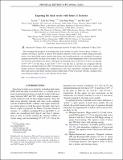| dc.contributor.author | Liu, Jia | |
| dc.contributor.author | Wang, Lian-Tao | |
| dc.contributor.author | Wang, Xiao-Ping | |
| dc.contributor.author | Xue, Wei | |
| dc.date.accessioned | 2018-06-04T18:37:03Z | |
| dc.date.available | 2018-06-04T18:37:03Z | |
| dc.date.issued | 2018-05 | |
| dc.date.submitted | 2018-04 | |
| dc.identifier.issn | 2470-0010 | |
| dc.identifier.issn | 2470-0029 | |
| dc.identifier.uri | http://hdl.handle.net/1721.1/116065 | |
| dc.description.abstract | We investigate the prospects of searching dark sector models via exotic Z-boson decay at future e⁺e⁻ colliders with Giga Z and Tera Z options. Four general categories of dark sector models, Higgs portal dark matter, vector-portal dark matter, inelastic dark matter, and axionlike particles, are considered. Focusing on channels motivated by the dark sector models, we carry out a model-independent study of the sensitivities of Z factories in probing exotic decays. The limits on branching ratios of the exotic Z decay are typically O(10⁻⁶–10⁻[superscript 8.5]) for the Giga Z and O(10⁻[superscript 7.5]–10⁻¹¹) for the Tera Z, and they are compared with the projection for the high luminosity LHC. We demonstrate that future Z factories can provide its unique and leading sensitivity and highlight the complementarity with other experiments, including the indirect and direct dark matter search limits and the existing collider limits. Future Z factories will play a leading role in uncovering the hidden sector of the Universe in the future. | en_US |
| dc.description.sponsorship | United States. Department of Energy (Award DE-SC-00012567) | en_US |
| dc.description.sponsorship | United States. Department of Energy (Award DE-SC-00015476) | en_US |
| dc.description.sponsorship | United States. Department of Energy (Award 669668-NEO-NAT-ERC-AdG-2014) | en_US |
| dc.publisher | American Physical Society | en_US |
| dc.relation.isversionof | http://dx.doi.org/10.1103/PhysRevD.97.095044 | en_US |
| dc.rights | Creative Commons Attribution | en_US |
| dc.rights.uri | http://creativecommons.org/licenses/by/3.0 | en_US |
| dc.source | American Physical Society | en_US |
| dc.title | Exposing the dark sector with future Z factories | en_US |
| dc.type | Article | en_US |
| dc.identifier.citation | Liu, Jia et al. "Exposing the dark sector with future Z factories." Physical Review D 97, 9 (May 2018): 095044 | en_US |
| dc.contributor.department | Massachusetts Institute of Technology. Center for Theoretical Physics | en_US |
| dc.contributor.mitauthor | Xue, Wei | |
| dc.relation.journal | Physical Review D | en_US |
| dc.eprint.version | Final published version | en_US |
| dc.type.uri | http://purl.org/eprint/type/JournalArticle | en_US |
| eprint.status | http://purl.org/eprint/status/PeerReviewed | en_US |
| dc.date.updated | 2018-05-31T18:00:15Z | |
| dc.language.rfc3066 | en | |
| dspace.orderedauthors | Liu, Jia; Wang, Lian-Tao; Wang, Xiao-Ping; Xue, Wei | en_US |
| dspace.embargo.terms | N | en_US |
| dc.identifier.orcid | https://orcid.org/0000-0002-6809-7545 | |
| mit.license | PUBLISHER_CC | en_US |
